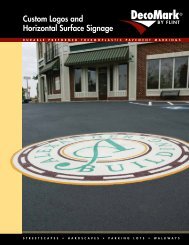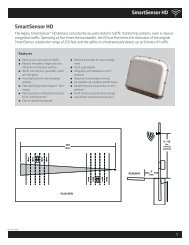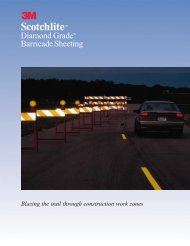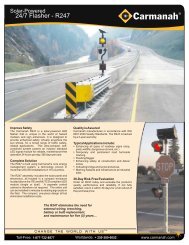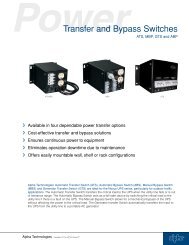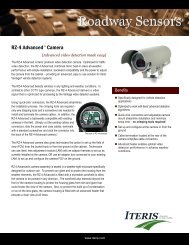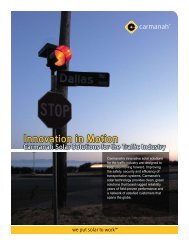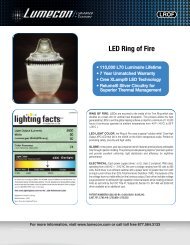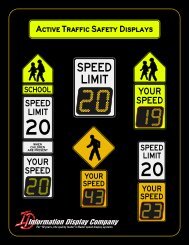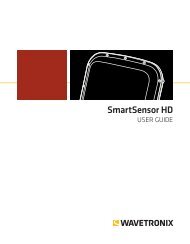Wavetronix SmartSensor Matrix - Interprovincial Traffic Services
Wavetronix SmartSensor Matrix - Interprovincial Traffic Services
Wavetronix SmartSensor Matrix - Interprovincial Traffic Services
Create successful ePaper yourself
Turn your PDF publications into a flip-book with our unique Google optimized e-Paper software.
<strong>SmartSensor</strong> <strong>Matrix</strong><br />
The communication ports shall support a 9600 bps baud rate.<br />
9.0 Radar Design. The RPD shall be designed with a matrix of 16 radars.<br />
The matrix of 16 radars enables the sensor to provide detection over a large area and to discriminate lanes.<br />
9.1 Frequency Stability. The circuitry shall be void of any manual tuning elements that could lead to human error and<br />
degraded performance over time.<br />
All transmit modulated signals shall be generated by means of digital circuitry, such as a direct digital synthesizer, that is<br />
referenced to a frequency source that is at least 50 parts per million (ppm) stable over the specified temperature range, and<br />
ages less than 6 ppm per year. Any upconversion of a digitally generated modulated signal shall preserve the phase stability<br />
and frequency stability inherent in the digitally generated signal.<br />
This specification ensures that, during operation, the RPD strictly conforms to FCC requirements and that the radar signal<br />
quality is maintained for precise algorithmic quality. Analog and microwave components within an RPD have characteristics<br />
that change with temperature variations and age. If the output transmit signal is not referenced to a stable frequency<br />
source, then the RPD is likely to experience unacceptable frequency variations which may cause it to transmit out of its<br />
FCC allocated band and thus will be non-compliant with FCC regulations.<br />
The RPD shall not rely on temperature compensation circuitry to maintain transmit frequency stability.<br />
Temperature-based compensation techniques have been shown to be insufficient to ensure transmit frequency stability.<br />
One reason this type of technique is not sufficient is that it does not compensate for frequency variations due to component<br />
aging.<br />
The bandwidth of the transmit signal of the RPD shall not vary by more than 1% under all specified operating conditions<br />
and over the expected life of the RPD.<br />
The bandwidth of an RPD directly affects the measured range of a vehicle. A change in bandwidth causes a direct error in<br />
the measured range, i.e., a 5% change in bandwidth would cause a range error of 10 ft. (3 m) for a vehicle at 200 ft. (61 m).<br />
If the bandwidth changes by more than 1% due to seasonal temperature variations and component aging, then the RPD<br />
will need to be frequently reconfigured to maintain the specified accuracy.<br />
9.2 Antenna Design. The RPD antennas shall be designed on printed circuit boards.<br />
Printed circuit board antennas eliminate the need for RF connectors and cabling that result in decreased reliability. Printed<br />
circuit antennas are less prone to physical damage due to their extremely low mass.<br />
The vertical beam width of the RPD at the 6 dB points of the two-way pattern shall be 65 degrees or greater.<br />
The antennas shall cover a 90 degree horizontal field of view.<br />
The sidelobes in the RPD two-way antenna pattern shall be -40 dB or less.<br />
Low sidelobes ensure that the performance from the antenna beam widths is fully achieved.<br />
9.3 Resolution. The RPD shall transmit a signal with a bandwidth of at least 245 MHz.<br />
The bandwidth of the transmit signal translates directly into radar resolution, which contributes directly to detection<br />
performance. For example, an RPD that transmits at a low bandwidth will have low radar resolution, which could cause it<br />
to count a single vehicle as two vehicles in adjacent lanes. As another example of the adverse effects of low radar resolution,<br />
the response from a sign or other radar target in the roadway may spill over into the lanes of travel and desensitize the<br />
radar. In order to achieve the specified detection accuracy in a variety of conditions, the unwindowed radar resolution cannot<br />
be larger than 2 ft. (0.6 m) at the half-power level, which requires a bandwidth of 240 MHz. The high radar resolution<br />
7



